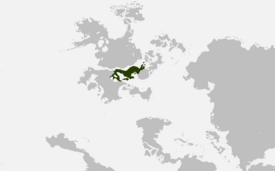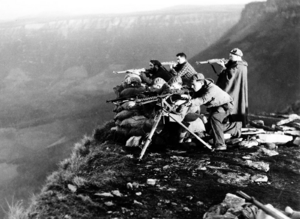Charville: Difference between revisions
No edit summary |
|||
| Line 62: | Line 62: | ||
|sovereignty_type = <!--Brief description of country/territory's status ("Independence [from...]", "Autonomous province [of...]", etc)--> | |sovereignty_type = <!--Brief description of country/territory's status ("Independence [from...]", "Autonomous province [of...]", etc)--> | ||
|sovereignty_note = | |sovereignty_note = | ||
|established_event1 = | |established_event1 = Charvillean Confederation | ||
|established_date1 = 3 August 1702 | |established_date1 = 3 August 1702 | ||
|established_event2 = Kingdom of Charville | |established_event2 = Kingdom of Charville | ||
|established_date2 = | |established_date2 = 14 February 1823 | ||
|established_event3 = Republic | |established_event3 = First Charvillean Republic | ||
|established_date3 = 3 August 1922 | |established_date3 = 3 August 1922 | ||
|established_event4 = Second Charvillean Republic<br>– Current constitution | |||
|established_date4 = 20 June 1967 | |||
|area_rank = | |area_rank = | ||
|area_km2 = 1,515,314 | |area_km2 = 1,515,314 | ||
Revision as of 10:23, 5 November 2023
Charvillean Republic Karvilensk Republikk (Oanthanian) Saaokiánntí Déʼéyóníkéyah (Distani) Taasineq Nunaqaqortuliaq (New Standard Highlandic) Cervilana Republika (Fendiralian) | |
|---|---|
Motto: Toleranse, Utholdonhett, Styrken "Tolerance, Perseverance, Strength" | |
 Charville (dark green) on a map centred on South Laurentia | |
| Capital and largest city | Aenva |
| Official languages | Oanthanian Distani Daralnian New Standard Highlandic Fendiralian |
| Ethnic groups (2024 census) | 69% Oanthanian 13% Indigenous —12% Distani Indigenous —1% Other Indigenous 9% Fendiralian 6% Daralnian 3% Other |
| Government | Federal parliamentary republic |
• President | Viktor Ulander |
• Prime Minister | Frances Øksendal |
| Legislature | Parliament |
| Rådmennget | |
| Forsemling | |
| Establishment | |
• Charvillean Confederation | 3 August 1702 |
• Kingdom of Charville | 14 February 1823 |
• First Charvillean Republic | 3 August 1922 |
• Second Charvillean Republic – Current constitution | 20 June 1967 |
| Area | |
• Total | 1,515,314 km2 (585,066 sq mi) |
• Water (%) | 2.46 |
| Population | |
• 2026 estimate | 44,127,888 |
• 2020 census | 43,325,066 |
• Density | 30.7/km2 (79.5/sq mi) |
| GDP (PPP) | 2025 estimate |
• Total | R1.697 trillion |
• Per capita | R39,183 |
| GDP (nominal) | 2025 estimate |
• Total | R1.285 trillion |
• Per capita | R29,304 |
| Gini (2024) | 50.2 high |
| HDI (2024) | very high |
| Currency | Rova (RVA) |
| Time zone | UTC-8 (Central Laurentian Time) UTC+1 (Fendiralian Time) |
• Summer (DST) | UCT-7 (Central Laurentian Summer Time) |
| Date format | dd/mm/yyyy |
| Driving side | right |
| Calling code | +25 |
| Internet TLD | .cv |
Charville, officially the Charvillean Republic, is a sovereign country located in central South Laurentia. The country is situated between the Strait of Laurentia to the north, and the Westland Gulf to the southwest. It borders Daraln to the east, The 7 Unions to the southwest, and The Celtics to the west. Charvillean Fendiralia in southeast Elisia borders Fendiralia to the north, and the Marlos Ocean to the south. Charville's 19 provinces span an area of 1,864,067 sq km (719,716 sq mi) and have a total population of over 43 million. Charville is a federal semi-presidential republic with its capital in Aenva, the country's largest city and main economic and cultural centre
The Celtics, The 7 Unions and Daraln in the west, southwest and east respectively. The Elisian Ocean is to the south, whilst the Strait of Laurentia is to the north. Charville is also comprised of one overseas territory in south-east Elisia, Charvillean Fendiralia, bordering the Fleet of Oceans and Fendiralia, and looking out into the Marlos Ocean. The total area of Charville is 1,864,067 sq km (719,716 sq mi), with a population at the 2024 census of 43,340,709. Charville is a federal semi- republic with its capital in Aenva, the country's largest city and economic and cultural centre; other major cities include Distanisci, Dâbucuta, Ekonsas, Port Dietten, Malidae City and Vastonyen.
Indigenous peoples have inhabited what is now Charville for thousands of years, in form of the nations of Distan, the vast Malideen Empire and various other tribes. The nation of Oanthan, with a primarily Nordesian population who had immigrated to South Laurentia over the course of the first millenium, was formed in 625, and with its large army and fast-growing population, completely subsumed the Malideen Empire by the 12th century. Hostility betweeen Distan in the west of modern-day Charville and Oanthan in the east ensued from the point of first contact onwards, and by the 13th century it erupted into full-scale combat between the two nations, sparking a series of conflicts that would later be known as the Three Hundred Years' War. Oanthan prospered in 16th and 17th century Telrova, with rapid economic and cultural growth, whilst Distan, humiliated by territorial losses to the former and widespread civil unrest, began to seek a integration deal with its neighbour to the east.
Oanthan and Distan unified in 1702, creating the federation of Charville. Both royal dynasties continued, ruling in conjuction until they were united by marriage in 1743, creating the singular House of Molvinger. Widespread poverty and economic decline, along with huge losses in the War of the Third Coalition would lead to the outbreak of a civil war in 1919. The Republicans led by Josef Schøien emerged victorious, establishing a semi presidential system and holding the first elections in Charville's history. A victory over Westland Daraln in the Fourth Coalition War solidified the new Republic's legitimacy. was granted independence in 1960 after a referendum, but the newly-formed government was immediately usurped by extremist group the Uprising, prompting a Charvillean-led invasion of the country in 1962. Victory against the Uprising was declared in 1965 and a war-torn Distan was admitted back into the federation the same year. The 1970s and 80s saw economic expansion for Charville, growth only halted in recent years by a series of recessions.
Charville has a high-income economy and a very high human development index rating. The country is known for its large finance industry and high amounts of economic freedom, and performs well in rankings of healthcare and education. The nation, however, suffers from high income inequality and an increase in terrorism in recent years, mainly through extremist group The Third Uprising. Charville is a member of the Telrovan Asssembly, United Federation of Telrova and the Group of Nations.
Etymology
The name of Charville derives from a word in the long-extinct Malideen language meaning 'two states': 'carvelli'. In a conference in 1698 that would begin the gradual unification of the nations of Oanthan and Distani, Oanthani minister Ulf Kaareson recalled the word from a history lecture several years prior, vocalising it as it would be pronounced in Oanthani: 'Charville'. The name stuck, and was used as a placeholder for the future country in the period leading up to the 1702 unification, and eventually for the country itself. Citizens of Charville are known as 'Charvilleans' but are sometimes informally called 'Chars'.
History
Pre-colonial
The first inhabitants of Laurentia are generally accepted to have migrated from West Elisia anywhere between 30,000 to 14,000 years ago, taking advantage of the land bridge present between the two continents during this time period. The earliest evidence of human presence in the region that would be modern-day Charville is dated around 11,000 BC. Over time, Ind
Nordesian nations

Charvillean Confederation and Kingdom
Charvillean Republic


Queen Oline, citing old age and stress from over 50 years of rule, abdicated from the throne in 1873 and was succeeded by her eldest son Ingolf. During his short reign of 3 years, Ingolf would pass discriminatr
Fighting broke out in February 1919, starting what would later be known as the First Charvillean Civil War. Having secured Distan and with growing support from the Charvillean working class, the Republicans pushed west into Malidae. Although outnumbered, the Royalists (comprised of most of the army and supporters of King John IV) were better trained and equipped, and won the majority of battles during 1919 and early 1920. Facing defeat, stepped down as Republican leader and was replaced by the revolutionary Josef Svensen. He employed foreign mercenaries and volunteers, restructured the Republican army and persuaded top Charvillean army generals to defect to his course. The retaking of Malidae City to the Republicans in October 1920 after a three-month siege marked a turning point in the war; Ekonsas was secured by Republican forces in March 1921, and in the other side of the country, Port Dietten in April, and Vastonyen in August. The decisive Republican victory and death of Royalist commander Crown Prince Karl at the Battle of Ordavik in January 1922 destroyed any chance of Royalist victory, and King John IV and his family fled to Socialist Platypus in March the same year. The majority of Royalist forces, however, would only surrender after Republicans took Aenva in April, with the Svensen declaring victory on 11 May 1922.
The Republicans began to implement their ideals of democracy, albeit set back by the divided and bankrupt nation they inherited.
Geography
Location and borders
Geology, topography and hydrography
Climate
Enviroment
Adminstrative divisions
| Province | Capital | Chief Minister | Area (km2) | Population | Density (people/km2) | GDP (PPP) | GDP (PPP) per capita | HDI |
|---|---|---|---|---|---|---|---|---|
| Distanisci | Eluukʼkan Nupeeto | 277,113 | 6,633,628 | 24.0 | R204 Billion | R30,827 | 0.811 | |
| Charvillean Fendiralia Territory | Dâbucuta | Luca Bumbescu | 4,790,316 | R30 Billion | R7,505 | 0.648 | ||
| North Oanthan | Vastonyen | 4,607,077 | R199 Billion | R43,148 | 0.905 | |||
| Dietten | Port Dietten | 4,090,525 | R174 Billion | R42,537 | 0.900 | |||
| Mansøorland | Åleske | 3,917,334 | R171 Billion | R43,589 | 0.902 | |||
| Malidae | Malidae City | 3,707,711 | R149 Billion | R40,220 | 0.870 | |||
| King Aasmund Island | Entälje | 1,728,864 | R85 Billion | R49,322 | 0.918 | |||
| The Highlands | Annukk | 389,964 | R13 Billion | R33,208 | 0.831 |
Didrik Stokkan, Anthoni Baardsen Annukk, Entälje, Åleske
Government and politics
Government
Law
Foreign relations
Military
Economy
Agriculture
Energy
Transport
Science and technology
Demographics
Population and major cities
Largest in Charville
As of the 2024 census | |||||||||
|---|---|---|---|---|---|---|---|---|---|
| Rank | Name | Province | Pop. | ||||||
 Aenva  Ekonsas |
1 | Aenva | Aenva City | 5,440,139 |  Dâbucuta  Distanisci | ||||
| 2 | Ekonsas | South Oanthan | 1,738,114 | ||||||
| 3 | Dâbucuta | Charvillean Fendiralia | 1,630,092 | ||||||
| 4 | Distanisci | Distan | 1,218,421 | ||||||
| 5 | Malidae City | Malidae | 1,009,135 | ||||||
| 6 | Vastonyen | North Oanthan | 744,199 | ||||||
| 7 | Port Dietten | Dietten | 680,855 | ||||||
| 8 | Oravibis | Charvillean Fendiralia | 644,811 | ||||||
| 9 | [[]] | Mansøorland | |||||||
| 10 | [[]] | Distan | |||||||
Ethnic groups
Migration
Languages
Religion
Education
Health
Culture
Literature
Music
Art
Architecture
Cinema
Cuisine
Media
Philosophy
Sports
Karvilensk Republikk (Oanthanian)
Saaokiánntì Dé’éyóníkéyah (Distani)
Republika Cervilana (Fendiralian)
1,515,314 km2


